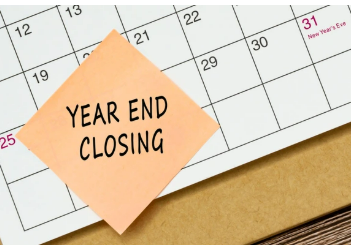🗓️ Year-End Checklist for Small Business Owners: Close the Books & Start the New Year Right
As the year comes to a close, small business owners have a lot to wrap up—from organizing finances to preparing for tax season and setting up for a strong start in the new year.
Not sure where to start? Here’s your step-by-step guide to closing out the year, filing 1099s, and getting your business financially ready for success in the new year.
✅ Step 1: Reconcile Your Books & Review Your Finances
Before you close out the year, make sure everything is accurate and up to date.
📌 Checklist:
✔️ Reconcile all bank accounts & credit cards – Ensure everything in your accounting system matches your bank statements.
✔️ Review income & expenses – Categorize transactions properly and flag anything that looks off.
✔️ Check for missing invoices or payments – Follow up on unpaid invoices and settle outstanding bills.
✔️ Verify loan balances – Ensure loan payments, interest, and principal amounts are correctly recorded.
💡 Why it matters: Cleaning up your books now means less stress at tax time and helps you spot opportunities for tax deductions.
✅ Step 2: Get Ready for 1099 Filing
If you paid independent contractors, freelancers, or vendors over $600 during the year, you need to file Form 1099-NEC.
📌 Who needs a 1099?
✔️ Contractors, freelancers, and service providers you paid $600+ via cash, check, or direct deposit.
✔️ Vendors providing services, not goods (e.g., graphic designers, consultants, subcontractors).
✔️ LLCs, Sole Proprietors, and Single-Member LLCs (unless taxed as an S-Corp or C-Corp).
📌 What to do now:
✔️ Collect W-9s – Ensure you have a completed W-9 from every contractor.
✔️ Review payment methods – Payments via PayPal (business), Venmo (business), or credit card are reported by the payment processor (no 1099 needed).
✔️ Set a filing deadline – 1099-NEC forms are due to the IRS and contractors by January 31st.
📢 Pro Tip: Avoid last-minute scrambling by reviewing your vendor payments now and requesting any missing W-9s before December 31st!
✅ Step 3: Maximize Tax Deductions & Make Last-Minute Moves
The last month of the year is your final chance to reduce taxable income and maximize deductions.
📌 Smart Year-End Tax Moves:
✔️ Buy business equipment or supplies – If you need a new laptop, tools, or software, purchasing before December 31st may allow you to deduct it this tax year.
✔️ Make final retirement contributions – Consider contributing to a SEP IRA or Solo 401(k) to reduce taxable income.
✔️ Review mileage & expenses – Ensure all deductible business expenses (travel, office expenses, home office deduction) are properly recorded.
✔️ Prepay expenses – If cash flow allows, paying for next year’s subscriptions, rent, or services now can help lower taxable income.
💡 Why it matters: Smart year-end tax planning can save you thousands and set you up for a strong start in the new year.
✅ Step 4: Set Goals & Prepare for a Strong New Year
The best way to start the new year right is to have a clear financial plan.
📌 Set yourself up for success:
✔️ Review this year’s financials – What worked? What didn’t? Where can you improve?
✔️ Set revenue & profit goals – Break them down into monthly or quarterly targets.
✔️ Create a cash flow plan – Map out expected income, expenses, and savings goals for the year ahead.
✔️ Upgrade bookkeeping systems – If your financial tracking felt messy this year, consider improving your bookkeeping workflows or switching to better accounting software.
📢 Pro Tip: The new year is a fresh start—so set yourself up for success by making bookkeeping easier and staying ahead of deadlines.
📞 Need Help Closing Out the Year & Preparing for 1099s?
At Crafty Books and Budgets, I help small business owners stay organized, reduce stress, and keep their books in top shape—so tax season is a breeze.
📩 Let’s chat! Schedule a free consultation today and start the new year with confidence.



